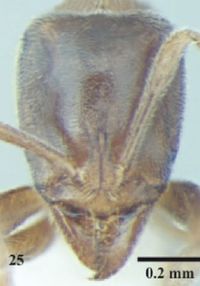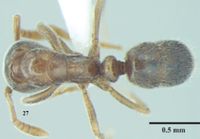Hypoponera shattucki
| Hypoponera shattucki | |
|---|---|

| |
| Scientific classification | |
| Kingdom: | Animalia |
| Phylum: | Arthropoda |
| Class: | Insecta |
| Order: | Hymenoptera |
| Family: | Formicidae |
| Subfamily: | Ponerinae |
| Tribe: | Ponerini |
| Genus: | Hypoponera |
| Species: | H. shattucki |
| Binomial name | |
| Hypoponera shattucki Bharti, Akbar, Wachkoo & Singh, 2015 | |
An uncommonly collected, apparently tropical species. Three type workers were collected from under a stone below a shady tree while others were obtained from winkler sampling.
Identification
Bharti et al. (2015) - H. shattucki shares most affinities with Sri Lankan endemic species Hypoponera ceylonensis from which it can be easily separated. H. shattucki is a dull coloured species with prominent eyes consisting of 3-4 ommatidia, mesonotal-mesopleural suture well marked and petiole squamiform; with the anterior and posterior faces convergent dorsally, whilst H. ceylonensis is mostly a smooth and shining species with eyes absent, mesonotal-mesopleural suture absent and petiole trapezoidal, with anterior and posterior faces not converging dorsally, and the dorsum of the node flat.
Keys including this Species
Distribution
Latitudinal Distribution Pattern
Latitudinal Range: 9.3° to 9.3°.
| North Temperate |
North Subtropical |
Tropical | South Subtropical |
South Temperate |
- Source: AntMaps
Distribution based on Regional Taxon Lists
Oriental Region: India (type locality).
Distribution based on AntMaps
Distribution based on AntWeb specimens
Check data from AntWeb
Countries Occupied
| Number of countries occupied by this species based on AntWiki Regional Taxon Lists. In general, fewer countries occupied indicates a narrower range, while more countries indicates a more widespread species. |

|
Estimated Abundance
| Relative abundance based on number of AntMaps records per species (this species within the purple bar). Fewer records (to the left) indicates a less abundant/encountered species while more records (to the right) indicates more abundant/encountered species. |

|
Biology
Castes
Nomenclature
The following information is derived from Barry Bolton's Online Catalogue of the Ants of the World.
- shattucki. Hypoponera shattucki Bharti, Akbar, Wachkoo & Singh, 2015: 46, figs. 25-27 (w.) INDIA.
Unless otherwise noted the text for the remainder of this section is reported from the publication that includes the original description.
Description
Worker
(holotype in brackets): HL 0.59-(0.61), HW 0.51-(0.53), HS 0.55-(0.57), SL 0.45-(0.46), PrW 0.35-(0.37), WL 0.75-(0.78), HFL 0.46-(0.48), PeNL 0.14-(0.16), PeH 0.33- (0.34), PeNW 0.26-(0.28), PeS 0.24-(0.26), CI 86-(87), SI (87)-88, PeNI 74-(75), LPeI 42-(47), DPeI (175)-185 (4 measured).
Eyes distinct, with 3-4 ommatidia. In full-face view apex of scape, when laid straight back from its insertion, reaches or very slightly exceeds the midpoint of the posterior margin; SI 87-88. Punctulate sculpture of cephalic dorsum fine and superficial, but dorsal head distinctly more densely sculptured than pronotal dorsum. Mid-dorsal longitudinal impression on head barely extends to the midlength of the vertex. Lateroventral areas of head weakly and superficially punctate. Propodeal dorsum almost smooth, with only faint, widely spaced, minute punctulae. In profile pro-mesonotum strongly convex, discontinuous at the deep metanotal groove; dorsum of propodeum oblique and lower than pro-mesonotum. Mesonotal-mesopleural suture present. Metanotal groove distinctly incised across dorsum of mesosoma; mesonotum with a defined posterior margin. Propodeal declivity separated from side by a blunt angle. Mesopleuron smooth and shining. Petiole squamiform; profile with the anterior and posterior faces of the node convergent dorsally; node distinctly longer just above the anterior tubercle than at the dorsum. Sternite of petiole in profile with a differentiated elongate lobe with sharp angles anteriorly and posteriorly. Maximum width of first gastral tergite in dorsal view about equal to the width of the second tergite at its midlength. Base of cinctus of second gastral tergite smooth, without cross-ribs. Post-tergite of second gastral segment, from posterior margin of cinctus to apex, broader than long. Punctures on disc of second gastral tergite superficial, minute and sparse. With first gastral segment in profile its dorsum with scattered standing setae. Body uniformly dull brown coloured.
Type Material
Holotype. Worker. India Arunachal Pradesh: Lumla, 2800m, 1 worker, 8.x.2013 (Coll. Shahid A. Akbar & Joginder Singh). India: Kerala, Periyar tiger reserve, Thanikkudy, 9.30°N, 77.16°E, 1003m a.s.l., 15.x.2011, Winkler method (coll. Shahid A. Akbar). Paratypes: 3 workers with same data as holotype. Holotype in Punjabi University Ant Collection and paratype in The Natural History Museum.
Etymology
The species is named after Dr. Steven Shattuck for his contributions to ant systematics.

